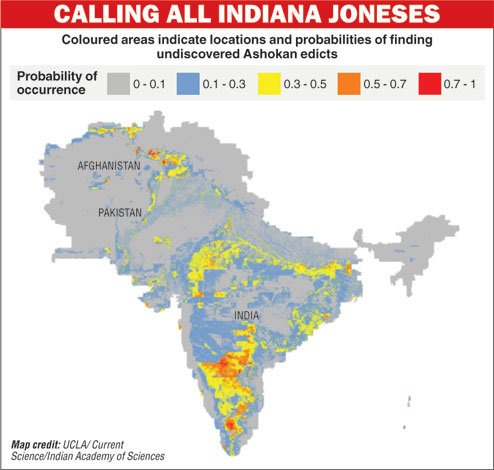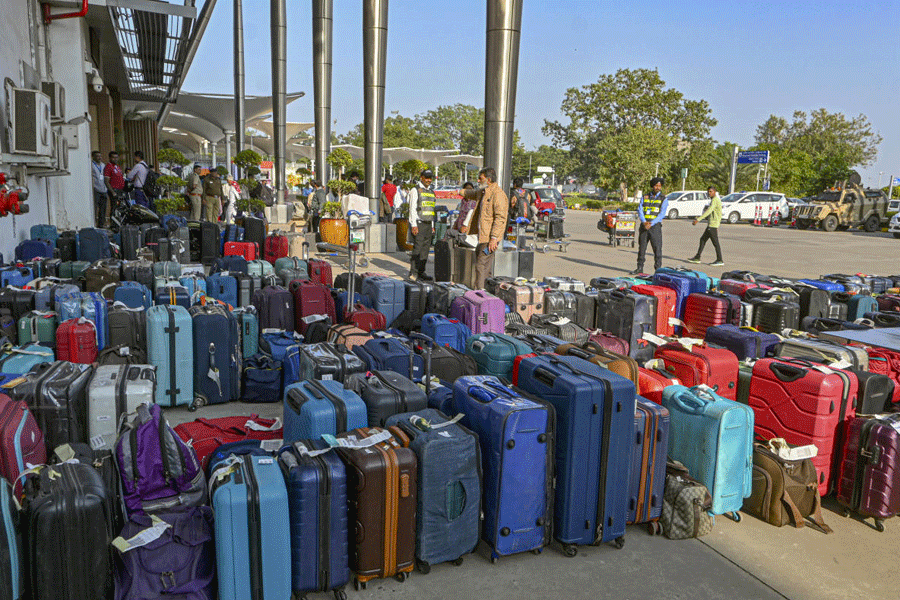New Delhi, May 15: An unusual partnership that combined archaeology, mathematics and wildlife science has predicted the possible locations of undiscovered inscriptions of Ashoka, the celebrated Mauryan emperor who left behind his proclamations on boulders and pillars.
Researchers at the University of California Los Angeles (UCLA) have generated a list of 121 sites represented on maps as 1km by 1km grids across the Indian subcontinent where they say there is a high likelihood of finding undiscovered edicts of Ashoka.
Archaeologists have over the past century found 31 Ashokan edicts inscribed on rocks across the subcontinent, from Kandahar in Afghanistan to Sahasram in Bihar and Jatinga-Ramesvara in Karnataka, and seven edicts on pillars concentrated in the eastern Ganga valley along the present-day India-Nepal border.
The inscriptions, mainly in the Brahmi script, are the first decipherable written records from the Indian subcontinent and provide insights into Ashoka's activities and thoughts, including his remorse after a great war in Kalinga and his support of Buddhism.

Now, archaeologist Monika Smith, biogeographer Thomas Gillespie and their colleagues at the UCLA have used a mathematical model to predict the locations of edicts yet to be discovered.
"The model predicts a high probability of finding edicts in these locations, but this is only a hypothesis," Gillespie told The Telegraph in a telephone interview. The locations are intended to guide archaeologists and other scholars when they select areas to search for more Ashokan edicts, he said.
The researchers borrowed a tool used in wildlife science called the species-distribution model that uses multiple ecology-related parameters such as the type and abundance of vegetation, terrain features, and climate to predict the presence and abundance of species.
They assumed that because the edicts were intended to spread the emperor's messages, those who etched the inscriptions were likely to pick sites that were near well-populated areas with appropriate boulders or rocks available to serve as the geological substrate. "We first trained and tested the model through the locations of the 31 known edicts," Gillespie said. "It is clear the sites of the known edicts are located in a non-random pattern."
All the edicts documented thus far had been chance finds during exploration or excavations, with the first recognised inscription linked to Ashoka documented in 1915. Archaeological papers suggest that inscriptions have been discovered about once every decade with the last finding from Ratanpurwa, Bihar, reported in 2009 by University of Lucknow archaeologist K.K. Thapliyal.
The UCLA team used a database of global population density through ancient times, geological features and climate parameters to generate the list of 121 sites where, the model predicts, the probability of finding undiscovered edicts is 70 per cent or higher.
The locations are clustered in pockets of central India and Afghanistan. The researchers have described the results of their study in Antiquity, a global journal of archaeology, and Current Science, a journal published by the Indian Academy of Sciences.
Sections of Indian archaeologists say the list of 121 locations may help narrow down areas for future search and excavations. But other scholars of ancient India caution that the usefulness, if any, of the methodology would depend on whether it yields discoveries.
"In archaeology, as in many other disciplines, the proof of the pudding is in the eating," Nayanjot Lahiri, professor of history at India's Ashoka University, Sonepat (Haryana), and author of the book Ashoka in Ancient India, published last August, told this newspaper.
"The predictive model outlined will carry credibility if discoveries are made there. That is what will make or unmake the model. We should wait for discoveries to be made before pronouncing on the importance or otherwise of this approach. For scholars and enthusiasts of ancient India, the discovery of an Ashokan edict is worth much more than a model which predicts such discoveries will take place," Lahiri said.
But Sheila Mishra, an archaeologist at the Deccan College, Pune, said: "The period of Ashoka's reign was a very important period of Indian history - even if we were to find just a few more edicts, it would be worth the effort."










